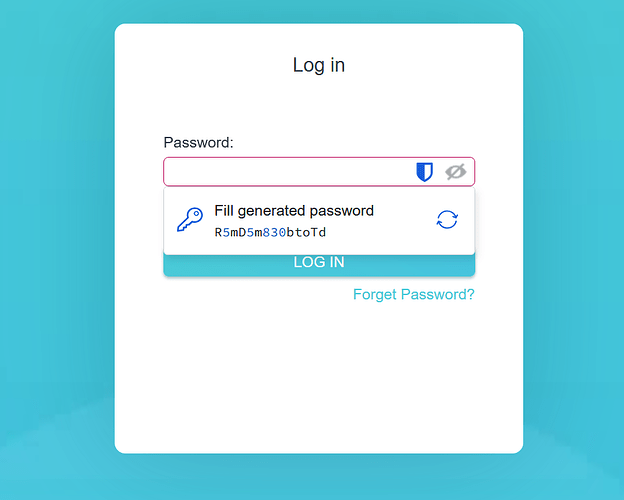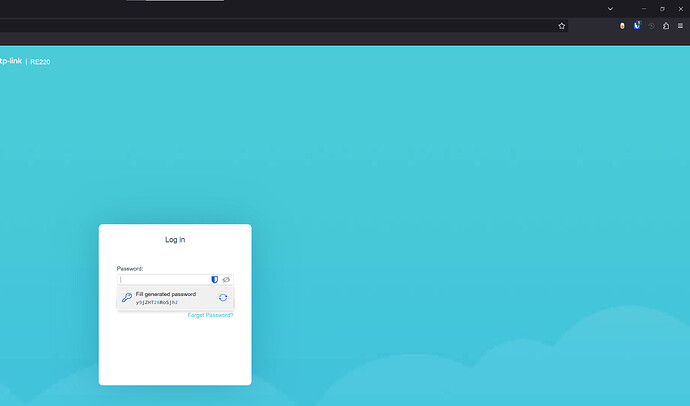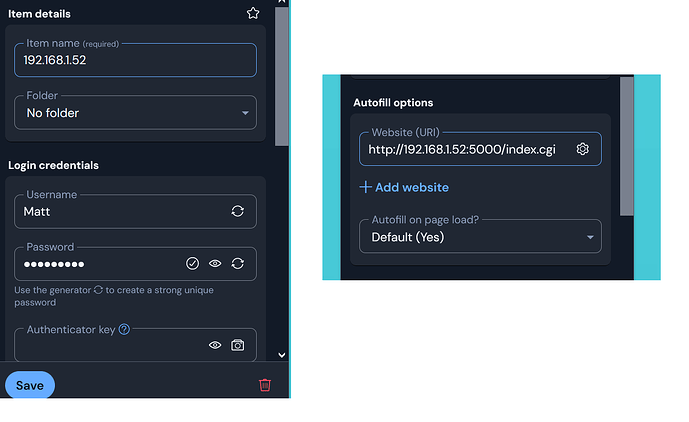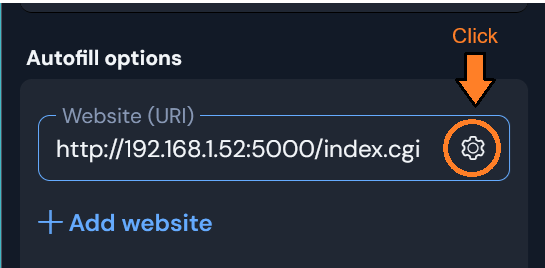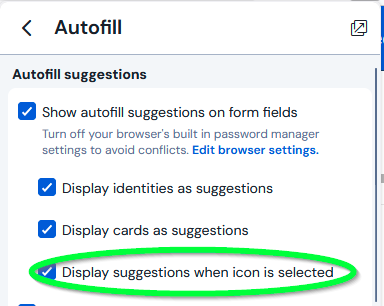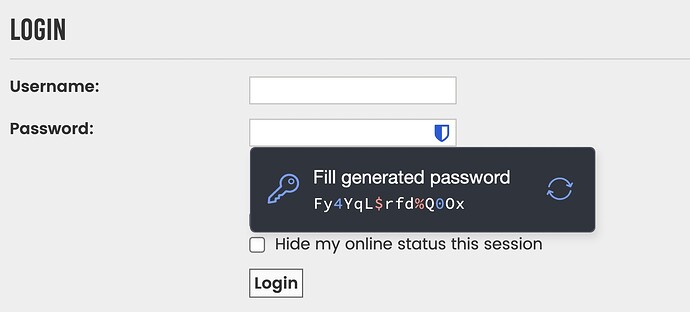The option to fill a generated password is ironically blocking an actual password. This is a slight inconvenience for me because when it does this I have to go into the vault and copy the password, but this became a problem for my elderly mother who I am trying to make computing as brain dead easy as possible, and she couldn’t figure out why she couldn’t sign in on a certain website where it wasn’t auto filling on the Edge browser with the Bitwarden extension for PC.
In what way does it block a password? - Do you mean, you would normally see the stored credential in the inline autofill menu and now only see the “generate password” suggestion instead of the credential??
This autofill overlay displays over the password suggestion overlay. Either it needs to appear on top or bottom of the password suggestion or be moved to the main menu of the extension
I cannot reproduce your issue (on an Edge browser).
Using your terminology, what is the difference between an “autofill overlay” and a “password suggestion overlay”, and what evidence do you have that the latter (the one you believe to be blocked) actually exists?
Are you using another password manager besides the Bitwarden browser extension?
In my testing, the “Fill generated password” overlay is only displayed when there is no matching login item in the vault. This suggests that your stored website URLs may be misconfigured.
Here is what I am experiencing on so far two different URLs and computers
The video had very low resolution, but I think I was able to make out what it was showing. However, I did not see any evidence that the “Fill generated password” overlay was covering up or blocking some actual password.
Could you please edit the login item in question, and click on the ![]() icon next to the Website URI, letting us know what has been selected there?
icon next to the Website URI, letting us know what has been selected there?
Also, please go to Settings > Appearance, and let us know whether the option “Show number of login autofill suggestions on extension icon” is checked or unchecked. If it is unchecked, please check it (and leave it checked until our troubleshooting is done).
If there is an actual bug here (which is yet to be determined), then my best guess is that it has something to do with the fact that you are using URIs that are local IP addresses with specific port numbers (e.g., 192.168.1.52:5000), and/or the fact that your protocol is http as opposed to https.
Could you please try this on a login form for a public web domain that uses https (for example, this Community Forum site, or a simple test form)?
I am seeing that there should be an autofill suggestion according to the extension icon, but the fill generated password overlay is all that I see. It also doesn’t autofill automatically like its configured to do. I will let you know if I find any more examples of this behavior
@Matt5,
It would help if you could provide responses to the rest of the questions that were asked.
What I meant was:
After clicking the ![]() icon, you will see a dropdown selector that governs the URI Match Detection behavior. What option has been selected in the dropdown?
icon, you will see a dropdown selector that governs the URI Match Detection behavior. What option has been selected in the dropdown?
It seems that the option is now enabled, but we lost some potentially valuable diagnostic information, because we don’t know whether this option was checked when you recorded your screen video yesterday.
Could you please do these tests as requested, and report back with your results?
Blockquote @Matt5, After clicking the
icon, you will see a dropdown selector that governs the URI Match Detection behavior. What option has been selected in the dropdown?
It is set to the default (base domain) option.
Blockquote [quote=“grb, post:7, topic:82856”]
Also, please go to Settings > Appearance, and let us know whether the option “Show number of login autofill suggestions on extension icon” is checked or unchecked.
[/quote]
It seems that the option is now enabled, but we lost some potentially valuable diagnostic information, because we don’t know whether this option was checked when you recorded your screen video yesterday.
I’m not an expert like you but I would think even if that option wasn’t enabled (which seems to just control the auto fill functionality), it should still display an overlay for the stored password suggestion. The point of the video is to show that there is a stored credential that is saved in the vault, that it detects when the URL is active, but instead of seeing a pop up to use that stored password, I only see an option to fill in a generated password instead.
So far I found it happens on a few URLs. Maybe it thinks I am trying to create an account instead of logging into an existing one? That would make sense because it is not auto filling the credentials either despite recognizing the URL and finding a match in the vault. On the test form you sent me it does not prompt me to fill in a generated password, as it properly detects it as a login and not a new account password field.
Could you please provide a list of those URLs? Are any of them not local IP addresses?
3 years later, and it’s still completely broken.
First off bitwarden extension blocks all website login boxes regardless if it has a login saved or not, and then when you give up and finally actually decide to use it to change a password it generates a logn random password and then doesnt allow you to save it… to get this far with a completly useful product is crazy. and yes I need more sleep but, cmon, you had one job.
@TonyCaruso Welcome to the forum!
Indeed, you woke up a very old thread (and that generation process you now presumably used, wasn’t even available back then)… Try to look into your generator history (“main menu” of the browser extension → Generator → scroll down: Generator history) - your generated passwords should be stored there.
Also, I think, there is some improvement coming to this process:
thanks yeah, the gen list is there, that wasn’t my gripe, it was this:
the extensions’s password auto gen kept popping up everywhere, even when I was just logging in, not creating a new account, , it even blocks the login box.
Very annoying, but I thought, at least I can create/save new passwords for sites quickly.. so I try it, I click to use the generated password.. a dead pop-up asks if I want BW to save (obviously I do!) and that does not register a click. So I use the extension to create an account and have to go manually save a login. It doesn’t make sense.
At least there’s ppl wth the same frustration on teh forum, oh wait that’s from 5 years ago lmao.
I moved your comments into a more relevant thread. The Bitwarden code base evolves quickly, and whatever was happening in the other thread from 2 years ago, I assure you that it is no longer relevant to the way that the browser extension is implemented today.
Can you please provide a list of a few URLs where you are seeing the “Fill generated password” pop-up when you are trying to log in to an existing account?
This can be adjusted in settings. Check this box and the shield icon will be added to the relevant fields, but the popup menu will not be displayed until you click the shield.
ok, fair enough, that makes sense.
Yes, every single website that exists. The pass gen pops up, and the one time it would be useful, i.e. when I’d be registering an account it won’t save the newly generated pass, so that voids the point.
Here’s a log in screen of one website as an example:
@DenBesten 's settings suggestion helps a lot, the extension suggests creating a password on a log in screen only if I click the BW logo, and now for some reason it is indeed allowing me to save newly created passwords when registering new accounts, when it wasn’t before. ![]()
In that case, the problem may be specific to the peculiarities of your setup, as the issue is not reproducible. If you would like help troubleshooting, please provide detailed information about your setup (self-hosted vs. cloud-hosted, operating system, browser, browser extension version, etc.).
